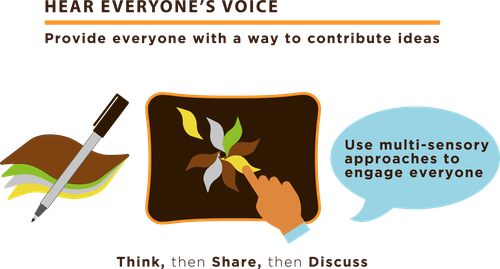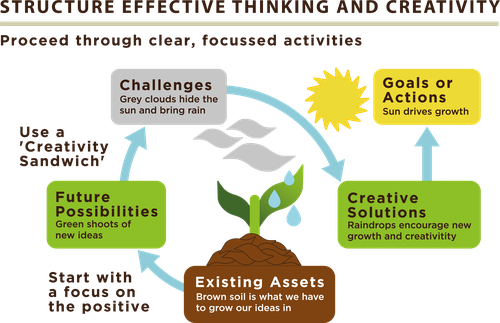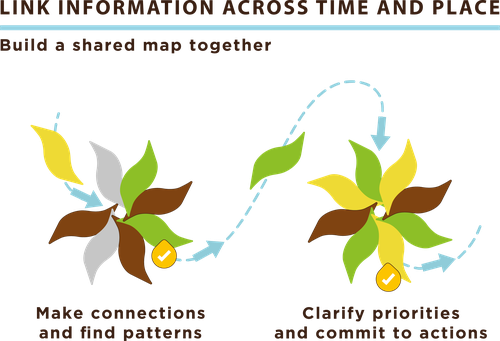Three Pillars of Effective Coproduction (and Participatory Data Gathering)
Introduction
Society is facing major environmental and social challenges, and tackling them will require new perspectives and ways of working together. Action tends to be more effective when people with lived experience, as well as a range of stakeholders involved in making changes, are engaged in planning and decision making. Coproduction is a way of working together where people with lived experience and organisational stakeholders both decide on what change is needed and to take action to bring it about.
Whilst there is widespread recognition of the value and importance of involving a wide range of people in decision making and change processes, it is not always clear how to do this effectively. One element of coproduction is running workshops and focus groups, which offer concentrated periods of time to explore issues, improve understanding and (where appropriate) develop ideas for action.
This tool builds on 25 years of experience of participatory workshops and coproduction (Tippett and How, 2020) to offer a practical way to plan effective workshops and participatory data gathering. We see the process of effective coproduction as being underpinned by the three pillars of:
- Hear everyone's voice.
- Structure effective thinking and creativity.
- Link information across time and place.
Each of these pillars offers key insights into effective participatory processes. They provide the core underpinning for the guidance and tool developed here, and are briefly introduced below in relation to planning workshops and focus groups.
To learn more about the pillars of coproduction, watch this brief video:
To learn more about participatory data gathering (with Ketso) watch this National Centre for Research Methods training video by Dr Tippett: https://www.ncrm.ac.uk/resources/online/all/?main&id=20729

Hear everyone's voice
The Hear everyone’s voice pillar is about ways to help us make sure we are taking the perspectives of multiple stakeholders into account. It is important that everyone in a workshop has a way to contribute ideas, and that the voices of diverse participants, not just those who speak the loudest, are actually heard. In practice, this can be encouraged by giving people the means to develop and share their ideas (putting the pen in the hands of the participants, and not just a scribe) and then having a process of “think, then share, then discuss” during data gathering / workshops. Giving participants a few moments of time on their own to develop their thinking before sharing their ideas gives the space for everyone to reflect. If these ideas are written or drawn down, then everyone can see that everyone else has some ideas to share.
Encouraging a structured turn-taking process (the sharing of ideas after developing them, then discussing ideas once everyone has contributed their thoughts further enables every voice to be heard). Using multi-sensory approaches (for instance encouraging writing, drawing, talking and moving ideas around) makes it more likely that all stakeholders will be engaged. Taking this pillar into account means that the people who will be affected, including the most vulnerable, as well as the people who have the power to effect change, are more likely to fully engage in the process and be listened to.
Structure effective thinking and creativity
As well as listening, effective coproduction requires more than just having a chat. Without clarity as to what is being asked and how ideas are being explored, workshops can be rather unfocused. Structuring effective thinking and creativity is aided by proceeding through a series of clear, focussed activities.
This pillar involves thinking about the way that ideas are explored and elicited, and we have found that it is important to start with the positive, “What works?” rather than with the negative “What are the problems?”. This helps shift the dynamic away from an ‘expert-led’ facilitation process towards a collaborative process of applying the existing knowledge and skills in to the room towards the topic.
This pillar points to the fact that it is possible to consciously apply creative thinking techniques. For instance, this workshop planning tool encourages the use of what we term a ‘Creativity Sandwich’. Rather like a ‘Feedback Sandwich’, in which some positive feedback is given both before and after any suggestions for improvement, a ‘Creativity Sandwich’ allows time for creative thinking scheduled into the plan before looking at problems, as well as after, in order to develop solutions to the problems. Following a process of structured creative thinking is more likely to lead to novel insights and possibilities that can lead to transformative change.


Link information across time and place
When planning a workshop or focus group, it is important to ask: “What do we already know about this topic?” and “Has any engagement happened in the past, and what was learned?”. This might suggest themes for structuring the dialogue, or other inputs such as prompts and key information for participants to consider during the process.
The pillar Link information across time and place is about enabling emergent learning, where participants make connections and find patterns through building a shared map together. The shared map enables participants to learn about what has gone before, reflect on the impact of previous or potential actions or interventions and then clarify priorities and commit to actions to navigate towards desired outcomes.
More information
For more information, see:
Tippett, J. and How, F. (2020). Where to lean the ladder of participation: a normative heuristic for effective coproduction processes.
Town Planning Review 91, (2), pp. 109-132.
https://www.liverpooluniversitypress.co.uk/journals/article/48504
Tippett, J., How, F., Barron, A. and Pottinger, L. (2021). Hands-On Engagement and Learning With Ketso in Barron, A., Browne A., Ehgartner U., Marie Hall, S., Pottinger, L. and Ritson, J. (eds.)
Methods for Change: Impactful social science methodologies for 21st century problems. ASPECT, pp. 250-259.
https://aspect.ac.uk/resources/research-method-hands-on-engagement-and-learning-with-ketso/
